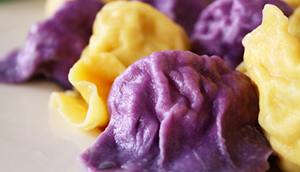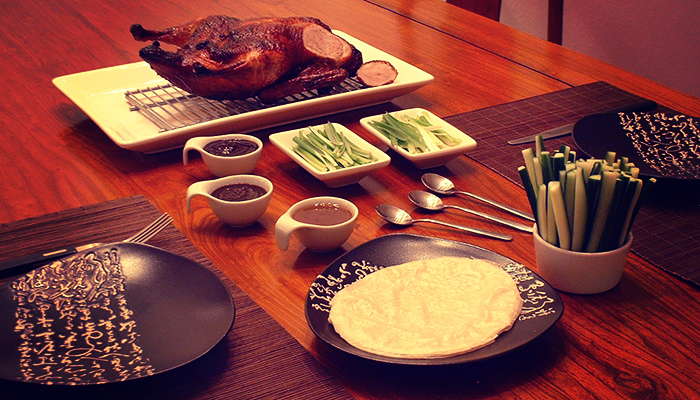
If there’s one thing you can count on doing in China, it’s eating. And in Beijing, the Middle Kingdom’s capital, keen diners will find a veritable cornucopia of dishes.
Peking duck
China’s national dish, once eaten only by the emperors, is lauded for its crispy brown skin and tender meat. Eating it is a DIY affair; dip the slices of duck in bean sauce before laying them on a delicate steamed pancake and topping them with spring onions, radishes or cucumber sticks, and a sprinkling of sugar. We recommend making a reservation at Duck de Chine, which has a branch right near Forbes Travel Guide Four-Star The Peninsula Beijing. The restaurant offers a très chic alternative to the more touristic Quanjude, and its tranquil courtyard is the only place in town to eat Peking duck alfresco.
Jianbing
This breakfast staple is available until the late afternoon but is most commonly eaten in the morning. Millet and bean flour is mixed to make a batter and then spread on a griddle just like a crepe. It’s topped with a cracked egg, scallions, chili paste, thick soy sauce and sometimes baocui, a long fried dough crisp. The jianbing is folded several times over and then neatly put in a plastic bag, the better to keep it warm and your hands free of oil. You’ll find jianbing on street corners across Beijing, including on the blocks just north of the Forbidden City.
Dumplings
Jiaozi (dumplings) are as iconic as Peking duck and come boiled, steamed or fried. During Beijing’s long, cold winter, we love tucking into a place that serves hot dumplings with flavorful fillings that burst forth at first bite. For dumplings whose exterior is as exciting as what’s inside, Baoyuan Jiaozi Wu uses fruit and vegetable dyes to color its skins. Choose your own skin and fillings, or order off the menu, which has options like purple-skinned dumplings stuffed with cabbage, bean sprouts, crispy rice and pork. Tucked inside Baochao Hutong, Mr. Shi’s Dumplings will perk up picky, jet-lagged kids, with a menu in English, a wall you can scribble on, and dumplings filled with cheese and even chocolate and banana, alongside more grown-up options like beef and fennel.
Zha Jiang Mian
These thick, chewy hand-pulled wheat noodles (mian) are topped with tangy stir-fried ground pork tossed in yellow or fermented soybean paste. A big handful of thinly sliced seasonal vegetables, such as radishes, cucumbers and bean sprouts not only add a nice texture, they also round out this simple, stick-to-your-ribs dish. Lao Beijing Zhajiangmian has branches across the city, including one near the Temple of Heaven’s east gate.
Mongolian Hot Pot
Like a steaming plate of dumplings, Mongolian Hot Pot will warm you inside and out during Beijing’s harsh winters. Hot pot — raw ingredients (meat, noodles, vegetables) cooked in a tableside pot of broth — is eaten throughout China. Beijing’s relatively close location to Mongolia makes your visit a good chance to try this meal. At Man Fu Lou, near the Forbidden City, you get your own individual copper pot, so you can make your broth as spicy as you want it to be. Service here is excellent, and waitstaff are always on hand to refill your broth. Expect trays of sliced meat striped with fat, chunks of tofu and bitter greens to flow from the kitchen. There’s quite an array of sauces to choose from, and you can mix your own; sesame and soy are nice, mild starters.


